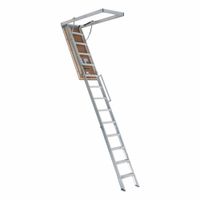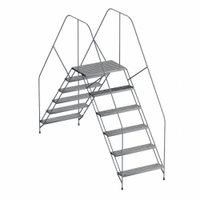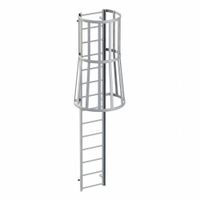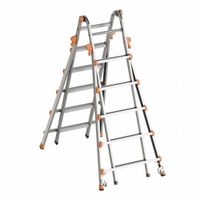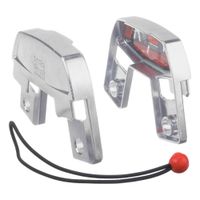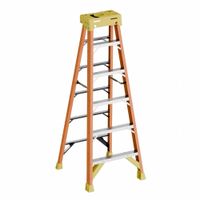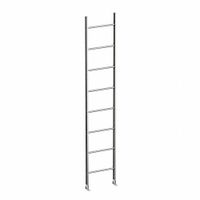Call +(254) 703 030 000 / 751 483 999 / 721 704 777
.....Read More
Frequently Asked Questions
What are the different types of ladders and their uses?
There are several types of ladders, each designed for specific tasks and environments:
1. **Step Ladders**: These are self-supporting ladders with flat steps and a hinged design, ideal for indoor tasks like painting or changing light bulbs. They are stable and easy to use.
2. **Extension Ladders**: Comprising two or more sections, these ladders can be extended to reach high places, making them suitable for outdoor tasks like cleaning gutters or accessing roofs.
3. **Telescoping Ladders**: These ladders can be extended and locked at various lengths, offering versatility for both indoor and outdoor use. They are compact and easy to transport.
4. **Multi-Position Ladders**: These versatile ladders can be configured into different shapes, such as step ladders, extension ladders, or scaffolding. They are useful for a variety of tasks and environments.
5. **Platform Ladders**: Featuring a platform at the top, these ladders provide a stable standing area, making them ideal for tasks that require extended periods of standing, like painting or electrical work.
6. **Attic Ladders**: Designed to provide access to attic spaces, these ladders are foldable and often built into the attic door for easy storage and access.
7. **Step Stools**: Smaller than step ladders, step stools are used for reaching low to medium heights, such as kitchen cabinets or closets.
8. **Roof Ladders**: Equipped with hooks to secure onto the roof ridge, these ladders are used for roof maintenance and repairs, providing stability on sloped surfaces.
9. **Articulated Ladders**: These have multiple locking hinges, allowing them to be used in various configurations, suitable for uneven surfaces or staircases.
10. **Fixed Ladders**: Permanently attached to structures, these ladders provide access to roofs or industrial equipment and are often found in commercial or industrial settings.
How do I choose the right ladder for my needs?
1. **Purpose**: Determine the primary use of the ladder. For indoor tasks like painting or changing bulbs, a step ladder might suffice. For outdoor tasks like cleaning gutters, consider an extension ladder.
2. **Height**: Measure the height you need to reach. For step ladders, choose one that allows you to work comfortably without standing on the top rung. For extension ladders, ensure it extends 3 feet beyond the roofline or working surface.
3. **Material**: Choose between aluminum, fiberglass, or wood. Aluminum is lightweight and rust-resistant, ideal for general use. Fiberglass is non-conductive, suitable for electrical work. Wood is sturdy but heavier and can rot if exposed to moisture.
4. **Weight Capacity**: Check the ladder’s duty rating, which indicates its maximum weight capacity. Ratings include Type III (200 lbs), Type II (225 lbs), Type I (250 lbs), Type IA (300 lbs), and Type IAA (375 lbs). Choose based on your weight plus any tools or materials you’ll carry.
5. **Stability and Safety Features**: Look for features like non-slip feet, wide rungs, and locking mechanisms. Consider ladders with stabilizer bars or platforms for added safety.
6. **Portability and Storage**: Consider the ladder’s weight and ease of transport. If space is limited, opt for a foldable or telescoping ladder.
7. **Frequency of Use**: For frequent use, invest in a durable, high-quality ladder. For occasional use, a basic model may suffice.
8. **Budget**: Balance cost with quality and features. Investing in a reliable ladder can prevent accidents and last longer.
9. **Compliance**: Ensure the ladder meets safety standards like ANSI or OSHA for added assurance.
What safety precautions should be taken when using ladders?
When using ladders, several safety precautions are essential to prevent accidents and injuries. First, always inspect the ladder before use to ensure it is in good condition, free from defects like cracks or missing parts. Choose the right ladder type and size for the task, ensuring it can support your weight and any tools you carry.
Set up the ladder on a stable, level surface. If the ground is uneven, use ladder levelers. For extension ladders, follow the 4-to-1 rule: for every four feet of ladder height, place the base one foot away from the wall. Ensure the ladder is fully extended and locked before climbing.
Maintain three points of contact (two hands and one foot or two feet and one hand) while on the ladder. Avoid overreaching; keep your belt buckle between the ladder rails. Climb facing the ladder, using both hands to grip the rungs, and never carry tools in your hands while climbing. Use a tool belt or hoist line instead.
Do not exceed the ladder's weight limit, which includes your body weight plus any tools or materials. Avoid using ladders in adverse weather conditions, such as high winds or rain, which can increase the risk of slipping or tipping.
Ensure the area around the ladder is clear of obstructions and hazards. If working near doorways, lock the doors or have someone guard them to prevent accidental openings. For added safety, have a spotter hold the ladder steady, especially when working at heights.
Finally, never use a ladder for purposes other than its intended use, such as a bridge or scaffold. Following these precautions can significantly reduce the risk of ladder-related accidents.
How do I properly maintain and store ladders?
To properly maintain and store ladders, follow these guidelines:
1. **Inspection**: Regularly inspect ladders for damage, such as cracks, corrosion, or loose rungs. Check for missing parts and ensure all moving parts function smoothly.
2. **Cleaning**: Clean ladders after use, removing dirt, grease, or chemicals. Use mild soap and water, and dry thoroughly to prevent rust or corrosion.
3. **Repairs**: Immediately repair or replace damaged ladders. Do not use ladders with structural defects.
4. **Lubrication**: Lubricate moving parts, such as hinges and locks, with a suitable lubricant to ensure smooth operation.
5. **Storage**: Store ladders in a dry, cool place away from direct sunlight and moisture. Hang ladders horizontally on wall brackets or store them vertically, ensuring they are stable and secure.
6. **Positioning**: When storing vertically, ensure the ladder is supported at both ends to prevent sagging. Avoid storing ladders near electrical hazards or in high-traffic areas.
7. **Protection**: Use ladder covers or pads to protect the ladder and surrounding surfaces from damage.
8. **Weight Limits**: Adhere to the ladder's weight capacity to prevent overloading and potential damage.
9. **Usage**: Follow the manufacturer's instructions for proper use and handling. Avoid using ladders for unintended purposes.
10. **Environment**: Store ladders away from extreme temperatures and chemicals that could degrade materials.
By following these steps, you can extend the lifespan of your ladders and ensure they remain safe and functional for future use.
What are the weight limits for different types of ladders?
Ladders are categorized by their duty ratings, which indicate the maximum weight they can safely support. These ratings are determined by the American National Standards Institute (ANSI) and Occupational Safety and Health Administration (OSHA) standards. Here are the common ladder types and their weight limits:
1. **Type III (Light Duty)**: These ladders are designed for household use and have a weight limit of 200 pounds. They are suitable for light tasks such as painting or changing light bulbs.
2. **Type II (Medium Duty)**: With a weight capacity of 225 pounds, these ladders are ideal for medium-duty tasks. They are often used by homeowners and for light commercial work.
3. **Type I (Heavy Duty)**: These ladders can support up to 250 pounds and are used for heavy-duty tasks. They are commonly used in construction and industrial settings.
4. **Type IA (Extra Heavy Duty)**: With a weight limit of 300 pounds, these ladders are designed for professional use. They are suitable for tasks that require carrying heavy tools or equipment.
5. **Type IAA (Special Duty)**: These ladders have the highest weight capacity of 375 pounds. They are used in specialized industrial applications where maximum strength and durability are required.
When selecting a ladder, consider the total weight it will need to support, including the user and any tools or materials. Always adhere to the manufacturer's guidelines and safety instructions to ensure safe usage.
How do I safely transport ladders?
To safely transport ladders, follow these steps:
1. **Choose the Right Vehicle**: Use a vehicle that can accommodate the ladder's length, such as a truck, van, or car with a roof rack.
2. **Inspect the Ladder**: Before loading, check the ladder for any damage or loose parts to ensure it is safe to transport.
3. **Secure the Ladder**:
- **Roof Rack**: If using a roof rack, position the ladder centrally. Use ratchet straps or bungee cords to secure it tightly. Ensure the ladder is parallel to the vehicle and does not extend excessively beyond the vehicle's front or rear.
- **Truck Bed**: Place the ladder flat in the truck bed. Use straps to secure it to the truck's tie-down points. If the ladder extends beyond the truck bed, attach a red flag to the end for visibility.
4. **Padding**: Use padding or foam to protect the ladder and vehicle from scratches or damage during transport.
5. **Visibility and Legal Compliance**: Ensure the ladder does not obstruct your view or vehicle lights. Check local regulations regarding overhanging loads and ensure compliance.
6. **Drive Carefully**: Drive at moderate speeds, especially on turns and rough roads, to prevent the ladder from shifting. Avoid sudden stops or sharp turns.
7. **Regular Checks**: Periodically check the ladder's security during long trips to ensure it remains tightly fastened.
By following these steps, you can transport ladders safely and securely, minimizing the risk of accidents or damage.
What are the regulations and standards for ladder use in the workplace?
Regulations and standards for ladder use in the workplace are primarily governed by the Occupational Safety and Health Administration (OSHA) in the United States. Key points include:
1. **General Requirements**: Ladders must be capable of supporting at least four times the maximum intended load. They should be inspected regularly for defects and removed from service if damaged.
2. **Portable Ladders**: Must have non-slip bases and be placed on stable, level surfaces. The angle of inclination should be such that the horizontal distance from the top support to the foot of the ladder is about one-quarter of the working length of the ladder.
3. **Fixed Ladders**: Must be equipped with cages, wells, or ladder safety devices if they are over 24 feet in height. The rungs must be uniformly spaced and capable of supporting a load of at least 250 pounds.
4. **Step Ladders**: Should be used only in the fully open position with spreaders locked. Users should not stand on the top two steps unless the ladder is designed for such use.
5. **Training**: Employers must provide training to ensure employees understand the proper use, placement, and handling of ladders. This includes recognizing hazards related to ladder use.
6. **Use and Positioning**: Ladders should not be moved, shifted, or extended while occupied. Users should maintain three points of contact (two hands and a foot, or two feet and a hand) when climbing.
7. **Prohibited Practices**: Ladders should not be used for purposes other than those for which they were designed. Metal ladders should not be used near electrical hazards.
These standards aim to minimize the risk of falls and injuries associated with ladder use in the workplace. Compliance with these regulations is mandatory to ensure worker safety.
